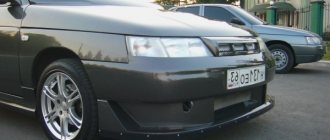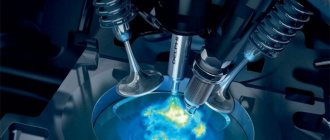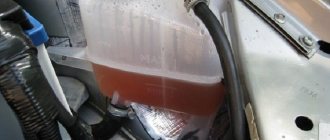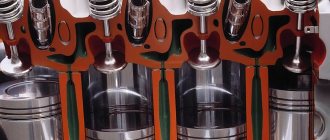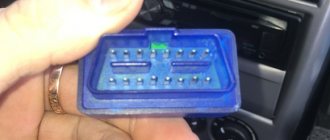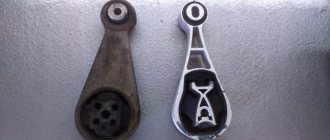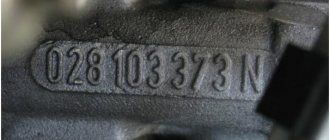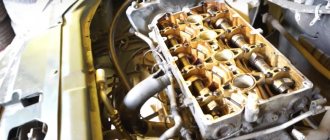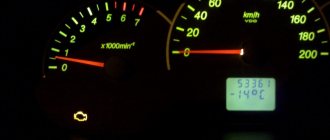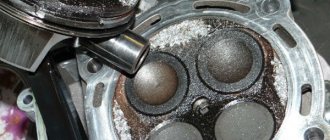Any extraneous noise in a car engine often makes owners feel wary. And although these sounds do not affect driving performance in any way, their very appearance makes the driver think about diagnostics. Many cars experience finger tapping during acceleration, but this problem is often ignored. The sound appears when the car picks up speed. If you do not pay attention to this in time, much more serious problems arise. At the same time, motorists cannot determine the causes of impacts, nor solve this problem. Let's look at the reasons for these unpleasant sounds in the driver's ear, and also find out how to fix these engine problems.
Knocking fingers
When the engine is running under load, ringing metallic sounds are heard. They disappear when you reach a certain speed. Old-school mechanics will say that the “fingers” knock when accelerating. However, the driver will be surprised and absolutely right: the sound has nothing to do with the “fingers” installed in the pistons.
Why "fingers"?
The combustion process of the combustible mixture in a fully operational engine occurs sequentially. A flame flares up near the candle and gradually fills the entire cylinder. But there is another combustion option - detonation. The explosion of the fuel mixture in the combustion chamber occurs suddenly. This increases pressure and temperature. This explosion itself is called detonation. Therefore, the driver hears a knock - it comes from the shock wave. Proper combustion requires a fire propagation speed of up to 30 m/s. The gas pressure gradually increases. During this combustion, the flame gradually fills the cylinder. The gases gently press on the piston. There is no detonation of gas along the walls of the combustion chambers, since there is no explosion. If the burning rate is higher, this is a prerequisite for an explosion. By the way, this phenomenon is very harmful to the engine.
Symptoms of sensor malfunction
You can determine whether the sensor is broken without a dashboard. But this will require experience and a special approach to your car. You need to know him very well. We list the signs by which you can understand that the device is broken, from here it will be immediately clear what the knock sensor affects:
- Fuel efficiency will drop. This may not be noticeable right away, but over time the driver will definitely notice it.
- Also, as the throttle increases, the engine detonates longer than usual. The knock sensor affects the acceleration of the car.
If you determine the breakdown yourself, then it’s not far to independently diagnose the sensor, as well as replace it yourself. In principle, this is not difficult, but it requires some understanding of the process.
Decarbonization of engine piston rings. - there is more useful information here.
If it requires replacement, then it is necessary to purchase a new device and install it as soon as possible. All car enthusiasts are primarily interested in the price of a new device. It is low and depends on the make of the car and on the country in which the part was manufactured.
Replacement can be done in several ways, the easiest way is to contact a specialist and pay money. On average, all this will cost 2000-3000 rubles.
You will be interested in this article - Flushing the injector, cleaning the injectors with your own hands.
You can carry out the replacement yourself when the engine has cooled down by disconnecting the negative terminal of the battery. It is necessary to achieve the most convenient access to the sensor so that it can be removed. The fact is that it also depends on the car model.
You can remove it with a 12 mm wrench; to do this you need to unscrew the bolt. Before you pull out the faulty device, unplug it. A new sensor is installed in the same place, and everything is repeated, but only in reverse order.
Thus, the knock sensor is a simple device, yet very useful for an electronic control system. It is not difficult to determine its malfunction; you can check it yourself, even in rural areas.
It will also be inexpensive to replace the sensor. It doesn’t matter whether this is done by a specialist or independently.
People, help out! How to overcome detonation? Detonation is always present, as soon as you press the trigger, in any gear! Firmware stock. I only use 95th gasoline: I tried all (!) gas stations, I filled it with “premium” and “euro” and 98th, with zero results! It did not arise suddenly, but gradually, somehow a little more and more. If you don’t accelerate too much, but pick up speed smoothly like a pensioner, then detonation will not occur. There is also a feeling that the pulling has become worse, somehow at speeds the engine is a little heavy and there is a kind of growling sound under load. Computer diagnostics did not find any problems, they said that all parameters were ideal.
Comments 67
Detonation? Maybe hydrikam kirdyk. It happened to me too, you press the gas, for example up a hill, and detonation appears. A neighbor advised me to look at the hydraulics. I took it apart and 10 out of 16 can be pressed with my fingers without any effort at all. Changed it and everything went away
I had the same problem, detonation appeared as soon as the engine warmed up... The diagnostics also showed nothing, all indicators were normal. Cured by rewiring the brain))))
Detonation on injection engines can mainly occur from glow ignition and a malfunction of any sensor. Glow ignition occurs on a warm engine from hot, unburned carbon particles on the piston, valves, cylinder head, and spark plugs. D. - a consequence of engine overheating, bad fuel, coked CPG, poor cooling, bad oil, hardened valve stem seals, bad spark plugs... there can be many reasons, right down to the engine temperature sensor constantly changing the engine temperature readings due to a malfunction (I heard about one such car on diagnostics). In short, I suggest starting with diagnostics.
Detonation - what is it?
If your “fingers” knock during acceleration, this indicates detonation in the engine. This is called an instantaneous and very destructive explosion of any flammable substance after impact or detonator activation. This is the definition according to Ushakov’s dictionary. Detonation of flammable substances in car engines is the rapid depletion of a mixture of gasoline and air. Occurs when the engine operates at low speeds and low-quality fuel. This process is accompanied by shocks, shocks, and increased temperature. As a result, the “fingers” knock during acceleration (including on the VAZ-2112).
Price
The knock sensor cannot be repaired and if it malfunctions, it only needs to be replaced with a new sensor. Fortunately, its price is not high, and there are also enough non-original, high-quality analogues on the market, which are listed below in the table. There are no differences between DD in engines with 8 and 16 valves; the sensors for both types of engines are exactly the same.
Below is a table with the article number and cost of the knock sensor for the Lada Priora
| Manufacturer | vendor code | Price (rubles) |
| LADA (original) | 21123855020 | 200-400 |
| Samara, 2112 | 3855020 | 180-250 |
| ERA | 550489 | 300-400 |
| "Road map" | 21123855020 | 250-360 |
| Decaro | 2112-3855020 | 380-500 |
| Fenox | SD10100O7 | 200-400 |
More about the reasons for knocking
When a car picks up speed, it creates a stressful situation for the engine. Especially if you need to suddenly accelerate the car. When the driver presses the accelerator pedal to the floor for a series of sharp turns, for example from one to six thousand, the driver hears the sound of “fingers” during acceleration (Priora is no exception).
Typical causes of ringing “fingers” during normal operation of the internal combustion engine
If the “fingers” knock during acceleration in the Kalina, the mass air flow sensor may fail. If it does not work properly, the ECU will receive incorrect information and issue incorrect commands. Another reason is that the ignition timing is incorrectly set. For this reason, the point at which the fuel will burn to the maximum extent possible is close to TDC. This leads to an increase in pressure in the combustion chamber. If your toes are clattering when accelerating on your Ford Focus, the shock suppression sensor may have failed. You should definitely check this item. If it stops working, it should be replaced.
How to avoid detonation?
Without exception, all modern cars are equipped with a special sensor and unit that reacts and suppresses this destructive phenomenon.
Replacement
Replacing the knock sensor on a Priora is quite easy to do yourself. This work will not cause any difficulties if you use the instructions described below.
First you need to prepare the tool:
- Ratchet with 13mm head;
- 10mm wrench;
- Wire brush;
- Screwdriver;
Replacement process
Replacing on a 16-valve engine is a little more complicated than on an 8-valve engine, so let’s consider the work using the example of an engine with 16 valves.
- We remove the negative mark from the battery, since the work will be performed on the electrical equipment of the car.
- We remove the air filter box by unscrewing the clamp from the mass flow sensor and removing the connector from it.
- Using your hand, through the hole between the radiator and the block, we approach the DD; it is located behind the crankcase gas hose (breather).
- Remove the sensor connector and use a ratchet with a 13mm socket to unscrew the sensor.
- Before installing a new sensor, it is necessary to clean the surface of the block from dirt.
- Install the new sensor in reverse order. The bolt must be tightened with a force of 20-25 Nm.
We hope our article was useful to you.
Engine detonation: main symptoms
Consequently, detonation is an uncontrolled chaotic process of fuel combustion, which is more like explosions in a cylinder. Additionally, these conditional breaks do not occur in a timely manner (for example, during the compression stroke while the piston is still moving up). As a result, the shock wave and high pressure cause severe loads on the elements of the CPG and the crankshaft, literally destroying the engine.
Detonation is determined not only by sound, but also by a number of other signs. First of all, the engine loses power when you press the throttle, and the engine may smoke a little when you press the accelerator pedal hard with gray-black smoke. Typically, severe detonation is accompanied by engine overheating; at idle and under load, the operation of the internal combustion engine can be extremely unstable, speed surges, etc.
Detonation and glow ignition
There are cases when detonation occurs when the ignition of a VAZ-2106 or any other version is turned off. That is, the power plant continues to operate independently even after the spark supply is stopped. Here, too, the process of self-ignition occurs, but it occurs for slightly different reasons. Such ignition occurs from some excessively heated elements of the CPG. This effect is called “glow ignition”, and this is no longer detonation of the VAZ-2106 engine. These two concepts should not be confused as they are completely different.
Why does detonation occur in engine cylinders?
Experts identify several main causes of fuel explosion in an engine.
- First of all, it is worth immediately highlighting the use of low-octane gasoline in units with a high compression ratio. Simply put, the octane number of gasoline (AI-92, 95 or 98) actually indicates its resistance to detonation, and not its quality, as many people mistakenly believe.
Using fuel with the wrong octane rating for a particular engine will naturally cause the fuel-air charge to explode under high compression. We also add that simple engines that do not have an engine control unit and a knock sensor are at increased risk.
- Coke engine. It is important to understand that modern engines not only in foreign cars, but also in domestic cars are very different from their analogues from the times of the USSR. Simply put, if the engines of the Moskvich 2141 model had a compression ratio of about 7 units and worked normally on any fuel, today the units have from 9 to 11 or more units.
- Violation of the mixture formation process. In this case, a too “rich” mixture, in which there is a lot of fuel in relation to the amount of air, may begin to detonate.
Please note that such an explosion may be short-lived and often goes unnoticed by the driver, but there is no evidence of engine failure.
- Ignition timing (IDA). Simply put, the ignition angle determines at what point the spark will be delivered to the combustion chamber. If we consider that normally fuel does not explode, but burns, it becomes clear that the combustion process also takes time.
In this case, it is important to ensure that the maximum pressure of gases on the piston, resulting from the combustion of part of the fuel, drops precisely at the moment of the piston’s working stroke. This is the only way to effectively transfer the energy of the expanding gases to the crankshaft through the piston.
To do this, the spark can be applied shortly before the moment when the piston reaches top dead center (TDC). During this time, the fuel will have time to ignite, and the expansion of gases and an increase in pressure on the piston will occur as soon as the piston has already reached TDC, and, therefore, will fall.
- Design features of the combustion chamber. It happens that some engines are naturally prone to detonation. In some cases, the reason is the combustion chamber itself, its cooling, etc.
Another culprit may be pistons that have an unsatisfactory thermal balance (for example, the piston head is thicker closer to the center, which greatly impairs the quality of excess heat removal). One way or another, the risk of detonation on such engines is much higher.
- Motor overheating. If you pay attention to the previous point, it becomes clear that the cause of detonation is an increase in temperature in the combustion chamber. It is clear that a decrease in the efficiency of the cooling system can lead to overheating of the engine.
Under such conditions, detonation is quite likely to occur, and detonation itself also leads to local and general overheating. For this reason, engine detonation due to a faulty cooling system is especially dangerous, since the power unit can not only be severely damaged, but cannot even be repaired in the future.
Detonation device on Priora
The knock sensor on the Priora is made in the shape of a circle, it has a hole for connecting wires. Inside it, in a special place, there are certain threads that, when detonation occurs, begin to emit impulses. The threads are made of a thin and rather soft alloy, and even though they are protected by a certain substance, it is under no circumstances recommended to throw the sensor forcefully onto the floor.
Detonation device on Priora
Where is
To improve the sensitivity of the knock sensor, it was installed on the Priora engine block. It is attached to a special ledge, as well as a platform, which is located near the second cylinder. This is where the noise from the detonation process is strongest. This place is located on the radiator side, just below the engine itself.
If the Priora is equipped with such technologies, in particular as power steering, air conditioning and many others, then access to them will be a little complicated, but still possible. Simply put, it is accessible from the front bumper of the car.
knock sensor location
Symptoms of a problem
The main malfunctions in the car's knock control system are:
- The device has failed.
- The wire to it broke.
- The device connector is broken.
In all these cases, eliminating all these troubles is an easy task. The main thing is to be able to identify them correctly. In any case, when working with a car with an ECM, diagnosing problems is a rather complex and important area of repair. Fixing the first two problems will require having the following kit on hand:
- Multimeter tester.
- Indicator light.
- Wires.
- Insulating tape.
- Wire cutters or knives.
Then connect the multimeter to the 2 holes of the connector and turn on the ignition. If everything is fine with the circuit, the tester will indicate a voltage of up to 5 Volts. And if nothing happened to the indicators, then the circuit may have broken and needs to be found. You need to disconnect the connector from the ECU and examine both circuits. Find the break and fix it using wires and electrical tape. If the tester shows a working circuit, then the problem is with the sensor.
How to eliminate engine detonation
So, having considered the main causes of engine detonation and understanding what it is, you can move on to how to get rid of this phenomenon. Let's start with old internal combustion engines. At first, you should exclude overheating of the engine, as well as refueling with low-quality or unsuitable fuel, and check the spark plugs.
The solution is temporary, since it is impossible to drive for a long time with a low ignition angle (the exhaust valves will burn due to an increase in the temperature of the exhaust gases), but it is quite possible to get to the service on your own.
However, while driving, it is necessary to constantly ensure that there are no characteristic “sounds” in the engine. Even on an old internal combustion engine, you can install a so-called electronic octane corrector to avoid manipulation of the distributor. Let us also add, as practice shows, many owners of carburetor cars prefer to install electronic ignition.
As for more modern engines, injection units are usually used to avoid or minimize the risk of detonation. This is an engine knock sensor (DE), which detects its occurrence. The corresponding signal is then sent to the ECU.
Then the control unit independently adjusts the ignition timing taking into account the data received from the DD. In this case, the possibility of such adjustment amounts to an average angular shift of 2-5 degrees. If detonation cannot be eliminated in this way, the ECU corrects the error and writes it into its memory, the “check” on the instrument panel may continue, the engine goes into emergency mode, and so on.
It becomes clear that in this case the driver must initially start by checking the knock sensor, and also read errors from the ECU memory. This can be done as part of computer engine diagnostics. You can also check this yourself (if you have a special diagnostic scanner adapter in the OBD connector and a smartphone/tablet or laptop with pre-installed software).
How to check engine performance using spark plugs. The main signs of engine malfunction are the appearance of black, gray, red and white carbon deposits on the spark plugs.
Marks for determining the correct setting of the ignition timing. Consequences of an incorrectly configured OZ, methods for setting the ignition.
Purpose and design of the knock sensor. The main causes of detonation, types and principle of operation of the sensor.
Why does the fuel-air mixture explode in the combustion chamber? Reasons causing detonation. Consequences of fire during fuel detonation in internal combustion engine cylinders.
Why does the engine overheat? What to expect as a driver and what damage may occur if the engine overheats. What to do if the internal combustion engine overheats.
Common malfunctions of the engine cooling system: water pump, thermostat, radiator, cooling fan and others. How to determine the reasons for yourself.
How to remove and check the sensor?
Access from above to the Priora DD is difficult due to the intake module located above it. The easiest way to get to the sensor is from below, first removing the engine protection or at least unscrewing and folding its front part. When working from above, you will have to do everything by touch. In any case, before starting work, it is necessary to disconnect the ground wire attached to the “negative” terminal from the battery.
To remove the crankcase protection, you need to:
- unscrew 5 nuts with a 10mm head;
- unscrew the 2 19 nuts installed on the back of the shield;
- remove protection.
- by pressing the metal latch of the DD connector, disconnect the block of wires going to the controller;
- using a 13mm wrench, loosen the bolt securing the sensor;
- Unscrew the bolt and remove it from the threaded hole, removing the sensor.
Photo of dismantling the knock sensor
- We connect a multimeter to the DD terminals. We set the device to voltmeter mode, choosing a measurement limit of up to 200 mV.
- We take a metal object - pliers or a bolt - and lightly tap it on the DD.
